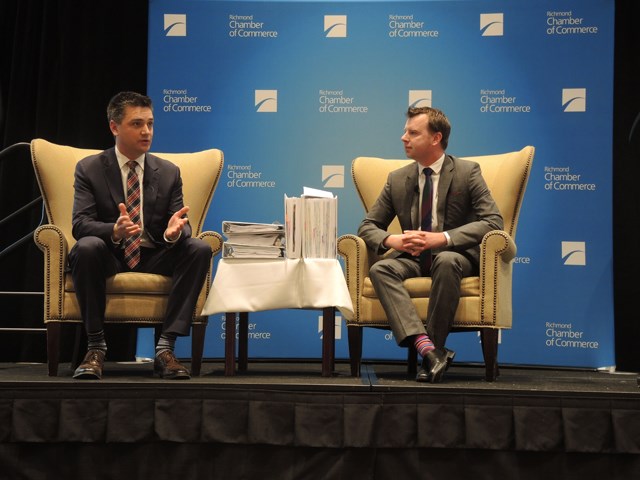Wednesday — if you were in B.C. Transportation Minister Todd Stone’s camp — was myth-busting day.
In front of a mainly Richmond Chamber of Commerce member audience at the Sheraton Vancouver Airport Hotel — and with a dozen or so vociferous protestors outside — Stone attempted to blow the so-called Massey Tunnel Replacement myths out of the water, so to speak.
Although directing his comments toward the rumour-mongers, conspiracy theorists and those with apparently ill-informed opinions, Stone did, at least, acknowledge that “British Columbians are engaged” in the consultation process for the proposed $3.5-billion, 10-lane, toll bridge over the south arm of the Fraser River.
First, he attacked the notion that the government’s project team hasn’t consulted properly, citing the 3,600 pages of information available, more than 100 meetings with stakeholders and three rounds of public consultation — results from the third round were released this week.
Second, those calling for a federal environmental assessment of the project — as opposed to the soon-to-take-place provincial version — were dismissed as being people who are never happy and insisted that the B.C. environmental review is “tough” and “world class.”
Stone added that nothing has happened, to date, that would actually trigger a federal review of the project.
Next up, the concept of a brand new tunnel, as opposed to a bridge, said Stone, “discounted thousands of hours of pain-staking effort by the project team” which looked into that option and apparently found that a new bridge is less expensive than a tunnel.
Finally, and likely the most prevalent of the “conspiracy theories,” Stone ripped into the assertion that, behind the scenes, it’s actually Port Metro Vancouver that’s driving the project in order to further industrialize the south arm of the Fraser.
“I hate to break it to the conspiracy theorists out there…but this project is driven from a place of safety,” Stone told the business lunch crowd.
“Is the port a stakeholder? Of course.”
The current tunnel, said Stone, is not the biggest impediment to allowing larger vessels access through the south arm, citing the Steveston Cut, Metro Vancouver pipelines and the inability for bigger container ships to turn around in the river.
While some in the conference hall may have been convinced by the minister, several, including Coun. Harold Steves, weren’t buying in.
“He still hasn’t answered several of (Richmond city council’s) questions and he keeps on giving different answers to the ones he does answer,” said a bemused Steves, seconds after Stone had finished talking.
“We still want to know what the cost of expanding the tunnel was back in 2006, when his predecessor (Kevin Falcon) told us that tunnel expansion was the way forward.
“They spent around $24 million at the time upgrading the tunnel and low and behold, three years later (in 2009), they’ve decided to build a bridge. How did that happen?”
Steves said he wants to know why $3.5 billion is being spent on a bridge, rather than adding more lanes to the tunnel.
He said city council is still hoping to get an answer by April 1, otherwise the city will use the freedom of information system to get the original plan for the tunnel.
Meanwhile, the provincial government released the results of its latest round of public consultation, claiming “general support” for the planned toll bridge.
However, of 874 respondents in open houses and other sessions, 44 per cent gave only conditional support for tolling, with either a lower toll or tolls on all bridges.
Another 13 per cent supported a standard toll at the new Massey Bridge, while 22 per cent opposed tolling entirely and 14 per cent wanted other funding sources used.
According to the feedback, Vancouver residents were more likely to back tolls, while Richmond residents typically said they could accept it if all bridges were tolled at a lower rate.
In answer to concerns around tolling, Stone said the bridge isn’t scheduled to be completed until 2022 and said lots of discussion can take place until then.
Of the 1,028 people who answered a question about the project scope, just five per cent said they had no concerns and 24 per cent said they were generally supportive. Another 31 per cent indicated conditional support, while 10 per cent were opposed.
In a brief sit-down, moderated question and answer session with chamber chair Rob Akimow, Stone was asked about a recent comment made by Amarjeet Sohi, the federal minister of infrastructure and communities, that the province had not made a formal request for funding for the bridge project.
“(Minister Sohi) corrected himself later that day; we have made a formal request through the P3 Canada program,” said Stone, who cited a “gap in communications” somewhere in the minister’s office.
“We’re quite hopeful we’ll see our federal partners coming to the table.”
In answer to another question from the crowd, through Akimow, Stone said that any forthcoming federal investment would not necessarily trigger the aforementioned federal environmental review.

.jpg;w=120;h=80;mode=crop)

